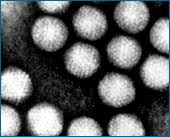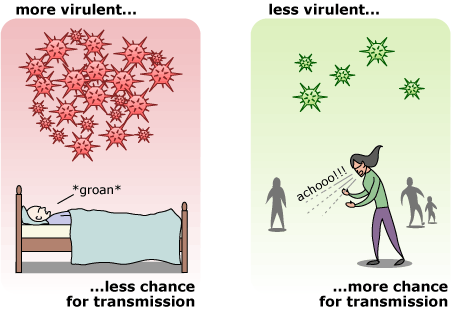
The new disease making the rounds this winter sounds like a Steven Spielberg movie in the making: a common cold virus, which spreads via casual contact, mutates into a virulent form that hospitalizes and sometimes kills its victims. Touted last month as the “killer cold,” Adenovirus-14 is far from fantasy, but neither is it scary enough to make a blockbuster. In the past 18 months, the virus has caused just 10 deaths — a minor toll when compared to the 36,000 caused by the flu in an average year. Why hasn’t Adenovirus-14 lived up to the threat advertised in headlines? Evolution helps explain why some bugs are killers, why others are not, and what chance a mutant cold virus has of reaching epidemic proportions.
Where's the evolution?
To understand why some germs are virulent, we need to see the world from their point of view. To us, disease-causing viruses and bacteria may be evildoers — invaders of our bodies — who, if they can be said to have any aim at all, it is to do us harm. But shifting our perspective to their scale reveals these pathogens to be evolving populations of organisms like any other, whose habitat just happens to be the human body. Like other organisms, these germs are shaped by natural selection to live and successfully reproduce. We view them as pathogens, however, because the resources they use to do this (and which they destroy in the process) are the cells of our own bodies. Many of the traits that make us feel sick during an infection are actually pathogenic adaptations — characteristics favored by natural selection that help these germs reproduce and spread.
As an example, consider a unique ecological challenge faced by many pathogens: appropriate habitats can be few and alarmingly far between. Put yourself in the position of a virus in its natural habitat — a human host. You’ve infected some cells and managed to reproduce, but the host’s immune system is onto you now and is turning up the heat. This environment is no longer so hospitable. How can you get your descendents to a friendlier habitat (i.e., a new, unexploited human body)? Without legs, wings, fins, or any of the usual means of locomotion, your descendents’ prospects for reaching a new host under their own power are nil. However, natural selection has provided pathogens with a number of sneaky strategies for making the leap to a new host, including:
- Droplet transmission — for example, being passed along when one host accidentally sneezes on another. The flu is transmitted this way.
- Airborne transmission — for example, being exhaled by one host and inhaled by another. Tuberculosis is transmitted this way.
- Vector transmission — getting picked up by a carrier (the vector — e.g., a mosquito) and carried to a new host. Malaria is transmitted this way.
- Waterborne transmission — leaving one host (e.g., in feces), infecting the water supply, and being taken up (e.g., in drinking water) by a new host. Cholera is transmitted this way.
- Sit-and-wait transmission — being able to live outside a host for long periods of time until coming into contact with a new host. Smallpox can survive for years outside of a host!
Pathogen lineages that fail to meet this challenge and never infect a new host are doomed. They will go extinct when their human host dies or when the immune system destroys the infection.
Since transmission is a matter of life or death for pathogen lineages, some evolutionary biologists have focused on this as the key to understanding why some have evolved into killers and others cause no worse than the sniffles. The idea is that there may be an evolutionary trade-off between virulence and transmission. Consider a virus that exploits its human host more than most and so produces more offspring than most. This virus does a lot of damage to the host — in other words, is highly virulent. From the virus’s perspective, this would, at first, seem like a good thing; extra resources mean extra offspring, which generally means high evolutionary fitness. However, if the viral reproduction completely incapacitates the host, the whole strategy could backfire: the illness might prevent the host from going out and coming into contact with new hosts that the virus could jump to. A victim of its own success, the viral lineage could go extinct and become an evolutionary dead end. This level of virulence is clearly not a good thing from the virus’s perspective.
Natural selection balances this trade-off, selecting for pathogens virulent enough to produce many offspring (that are likely to be able to infect a new host if the opportunity arises) but not so virulent that they prevent the current host from presenting them with opportunities for transmission. Where this balance is struck depends, in part, on the virus’s mode of transmission. Sexually-transmitted pathogens, for example, will be selected against if they immobilize their host too soon, before the host has the opportunity to find a new sexual partner and unwittingly pass on the pathogen. Some biologists hypothesize that this trade-off helps explain why sexually-transmitted infections tend to be of the lingering sort. Even if such infections eventually kill the host, they do so only after many years, during which the pathogen might be able to infect a new host.
On the other hand, diseases like cholera (which causes extreme diarrhea) are, in many situations, free to evolve to a high level of virulence. Cholera victims are soon immobilized by the disease, but they are tended by others who carry away their waste, clean their soiled clothes, and, in the process, transmit the bacterium to a water supply where it can be ingested by new hosts. In this way, even virulent cholera strains that strike down a host immediately can easily be transmitted to a new host. Accordingly, cholera has evolved a high level of virulence and may kill its host just a few hours after symptoms begin.
Though transmission mode is far from the only factor that affects how virulence evolves — the immunity level of the host population, the distribution of the hosts, and whether the host has other infections, for example, matter as well — this key piece of the pathogen’s ecology does help illuminate why some diseases are killers. More importantly, it suggests how we might sway pathogen evolution towards less virulent strains. In situations where high virulence is tied to high transmission rates (e.g., cholera), reducing transmission rates (e.g., by providing better water sanitation) may favor less virulent forms. The idea is to create a situation in which hyper-virulent strains that soon kill or immobilize their hosts never get a chance to infect new hosts and are turned into evolutionary dead ends. In fact, biologists have observed this phenomenon in South America: when cholera invaded countries with poor water sanitation, the strains evolved to be more virulent, while lineages that invaded areas with better sanitation evolved to be less harmful.
And that brings us back to Adenovirus-14. Adenoviruses are transmitted through the air or via contact. We might expect this sort of transmission to require a fairly healthy host (one who gets out and comes into contact with others) and, hence, to select against virulent strains. Indeed, adenoviruses are rarely killers, but in close quarters — for example, in the military barracks where Adenovirus-14 has been a particular problem — barriers to transmission may be lowered. This could open the door for the evolution of more virulent strains. Military personnel, however, are in the process of pushing this door shut again. At Lackland Air Force Base, which has seen the most serious outbreak of Adenovirus-14, wider testing, more hand-washing stations, increased attention to sanitization, and isolation of patients is helping to reduce the transmission of the disease and, in the process, may favor the evolution of less virulent strains of the virus.
Primary literature:
- Ewald, P. W. (1996). Guarding against the most dangerous emerging pathogens: Insights from evolutionary biology. Emerging Infectious Diseases 2(4):245-257. Read it »
- Galvani, A. P. (2003). Epidemiology meets evolutionary ecology. Trends in Ecology and Evolution 18:132-139. Read it »
News articles:
- A news report on Adenovirus-14 from Reuters
- An interview on managing the evolution of disease virulence from WGBH
Understanding Evolution resources:
- Review some background information on natural selection. Explain how a mutation allowing a virus to make more copies of itself would spread through a population of viruses living within a single person. Make sure to include the concepts of variation, selection, and inheritance in your explanation.
- Read more about the concept of evolutionary fitness. Describe what factors would increase the evolutionary fitness of a virus like Adenovirus-14.
- Explain what an evolutionary trade-off is. Be sure to include the concept of fitness in your explanation.
- Consider a disease transmitted from mother to child before or soon after the child is born. In this situation, would a pathogen be likely to evolve high or low levels of virulence? Explain your reasoning.
- Consider the disease malaria, which is passed from person to person when one is bitten by a mosquito that has previously bitten an infected individual. Would the pathogen that causes malaria be likely to evolve high or low levels of virulence? Explain your reasoning.
- This article describes how evolution might shape pathogen virulence. Do some research and describe at least one other example of pathogen evolution observed by people.
- Teach about the evolution of virulence: In this short video for grades 9-12, evolutionary biologist Paul Ewald describes strategies for controlling viral evolution.
- Teach about applications of evolutionary biology in medicine: This tutorial for grades 9-12 explores just a few of the many cases in which evolutionary theory helps us understand and treat disease. Bacterial infections, HIV, and Huntington's disease are highlighted.
- Cases of 'boot camp flu' dropping at Lackland AFB. (2007, December 3). AP Texas News. Retrieved December 4, 2007, from Houston Chronicle
- Centers for Disease Control and Prevention. (2007, November 16). Acute respiratory disease associated with Adenovirus Serotype 14. Morbidity and Mortality Weekly Report. Retrieved December 4, 2007, from CDC
- DeNoon, D. J. (2007, November 20). Killer cold virus: Questions, answers. WebMD Medical News. Retrieved December 4, 2007 from WebMD
- Ewald, P. W. (1996). Guarding against the most dangerous emerging pathogens: Insights from evolutionary biology. Emerging Infectious Diseases 2:245-257.
- Galvani, A. P. (2003). Epidemiology meets evolutionary ecology. Trends in Ecology and Evolution 18:132-139.

